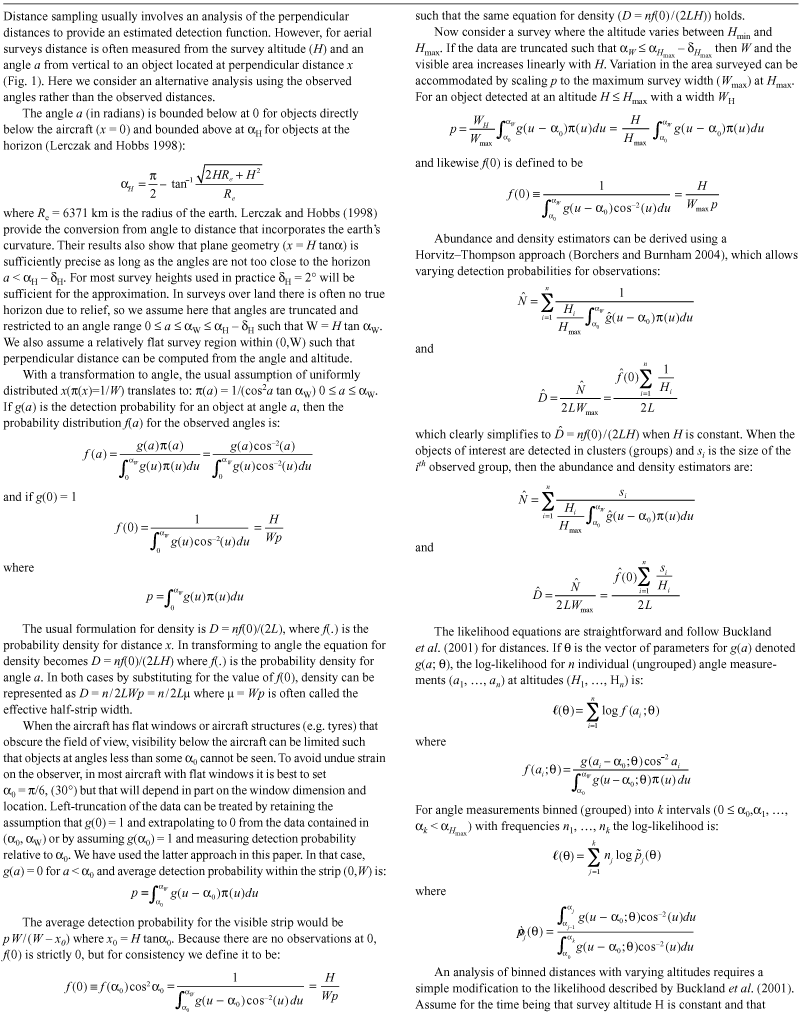Coping with variation in aerial survey protocol for line-transect sampling
Jeff Laake A D , Richard J. Guenzel B , John L. Bengtson A , Peter Boveng A , Michael Cameron A and M. Bradley Hanson CA National Marine Mammal Laboratory, Alaska Fisheries Science Center, National Marine Fisheries Service, Seattle, WA 98115, USA.
B Wyoming Game and Fish Department, Laramie, WY 82070, USA.
C Northwest Fisheries Science Center, National Marine Fisheries Service, Seattle, WA 98112, USA.
D Corresponding author. Email: jeff.laake@noaa.gov
Wildlife Research 35(4) 289-299 https://doi.org/10.1071/WR07065
Submitted: 8 June 2007 Accepted: 12 December 2007 Published: 27 June 2008
Abstract
Altitude and flight speed affect detection probability and they typically vary during the course of most aerial surveys. We demonstrate how these sources of variation can be accommodated with covariates in a line-transect analysis using data from a pronghorn (Antilocapra americana) survey in Wyoming and a survey of Antarctic ice seals (Lobodon carcinophaga, Leptonychotes weddellii, Hydrurga leptonyx, Ommatophoca rossii). We also show how the likelihood for binned distance data can be modified to allow for variation in altitude. As an alternative, we develop an estimator for aerial line-transect sampling based on vertical angles rather than distance. With a small simulation study, we show that our estimators are unbiased and are preferable to using biased estimators based on fixed-distance intervals derived from average altitude.
Acknowledgements
The seal survey was supported by National Science Foundation grant OPP-9815961 to Bengtson, Boveng and Laake. The Wyoming Game and Fish Department has been instrumental in the development and implementation of distance sampling in pronghorn management by providing continued support for the development of improved methodology. We thank Devin Johnson, Rod Hobbs, Gary Duker, Jim Lee, Richard Barker and an anonymous reviewer for suggesting improvements to the manuscript.
Ackley, S. F. , Bengtson, J. L. , Boveng, P. , Castellini, M. , and Daly, K. L. , et al. (2003). Ecological importance of summer pack ice in the eastern Ross Sea, Antarctica, to seals, penguins, and their prey. The Polar Record 39, 219–230.
Borchers, D. L. , Laake, J. L. , Southwell, C. , and Paxton, C. G. M. (2006). Accommodating unmodelled heterogeneity in double-observer distance sampling surveys. Biometrics 62, 372–378.
| Crossref | GoogleScholarGoogle Scholar | PubMed |
Caughley, G. (1974). Bias in aerial survey. Journal of Wildlife Management 38, 921–933.
| Crossref | GoogleScholarGoogle Scholar |
Johnson, B. K. , Lindzey, F. G. , and Guenzel, R. J. (1991). Use of aerial line transect surveys to estimate pronghorn populations in Wyoming. Wildlife Society Bulletin 19, 315–321.
Quang, P. X. , and Lanctot, R. B. (1991). A line transect model for aerial surveys. Biometrics 47, 1089–1102.
| Crossref | GoogleScholarGoogle Scholar |
Samuel, M. D. , Garton, E. O. , Schlegel, M. W. , and Carson, R. G. (1987). Visibility bias during aerial surveys of elk in north central Idaho. Journal of Wildlife Management 51, 622–630.
| Crossref | GoogleScholarGoogle Scholar |
Southwell, C. , de la Mare, B. , Underwood, M. , Quartararo, F. , and Cope, K. (2002). An automated system to log and process distance sight–resight aerial survey data. Wildlife Society Bulletin 30, 394–404.

|

|


